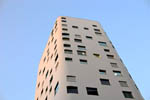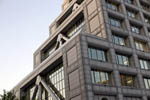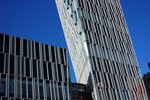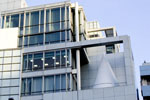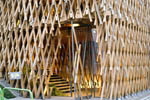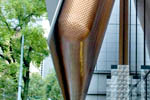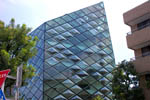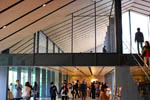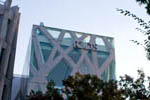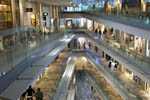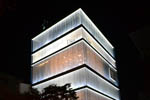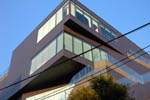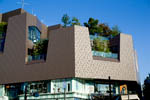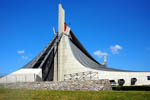Architecture Tour - Aoyama, Harajuku
Sia Aoyama Building - Notable building: Omotesando
The facade of this nine-story rental office building is punctuated by seven different types of window, ranging from 1.5 to 2.2 meters in size. Ceilings are a luxurious 4.9 meters in height. The building was designed by Jun Aoki and Associates, and it was completed in 2008.
United Nations University - Notable building: Omotesando
Another marquee project from renowned architect Kenzo Tange, the United Nations University headquarters building occupies a prominent location in Aoyama, across the street from Aoyama Gakuin University. It was completed in 1992.
Ao - Shopping complex: Omotesando
With its striking silhouette, this shopping and office complex stands out against the Aoyama skyline. The building was completed in 2009, designed by the architectural firm of Sakakura Associates.
Spiral Building - Notable building: Omotesando
Pritzker Prize-winning architect Fumihiko Maki designed this Aoyama landmark, which was completed in 1985. There is an excellent design shop on the second floor.
Sunny Hills - Cafe: Omotesando
The three-dimensional wooden lattice of Japanese cypress covering the facade of this building was created using traditional wooden construction techniques. The building houses a Taiwanese pineapple cake shop, and the overall form evokes the image of a bamboo basket. Completed in 2014, it is the work of architect Kengo Kuma, who was also responsible for the nearby Nezu Museum.
Miumiu - Notable building: Omotesando
[Open 11am-8pm daily.]
Completed in 2015, this understated building is the work of the Swiss architectural firm of Herzog & de Meuron. Miu Miu is a sister brand of Prada, and the same architectural firm was responsible for the much more showy Prada building diagonally across the street from here.
Prada - Notable building: Omotesando
[Open 11am-8pm daily.]
The striking lozenge-shaped glass panels that make up the facade of the Prada building are varyingly concave, convex and flat in curvature, resulting in ever-changing visual impressions as you move around the interior or exterior. The building occupies only a small portion of its site, leaving room for an open plaza-like space in front. Completed in 2003, it is the work of the Swiss architectural firm of Herzog & de Meuron.
Nezu Museum - Art museum: Omotesando
[Open 10am-5pm (enter until 4:30pm). Closed Mondays.]
This stunning museum building was designed by architect Kengo Kuma and opened in 2009. If you have time to spare, the museum specializes in pre-modern art from Japan, China, and other Asian countries, with some 7000 items including painting and sculpture, calligraphy, ceramics and lacquerware. The museum cafe is also worth a stop, and it looks out onto a beautiful wooded garden which you can stroll through after taking in the exhibition.
Tod's Omotesando - Notable building: Harajuku
The curving, organic-looking shapes of the glass and concrete facade of Tod's are inspired by the zelkova trees that line the Omotesando boulevard. The building was designed by architect Toyo Ito and was completed in 2004.
Omotesando Hills - Shopping complex: Harajuku
This very stylish seven-story shopping and restaurant complex features mostly small boutiques and luxury brands. The structure was designed by architect Tadao Ando and completed in 2006.
Dior Omotesando - Notable building: Harajuku
The Christian Dior building on Omotesando, completed in 2003, is the work of Tokyo's SANAA firm, founded by Kazuyo Sejima and Ryue Nishizawa. The firm were also responsible for the 21st Century Museum of Contemporary Art in Kanazawa. With its shimmering illuminated facade, the building is especially striking after dark.
GYRE - Notable building: Harajuku
Echoing the spiral forms of Fumihiko Maki's Spiral Building and Tadao Ando's Omotesando Hills nearby, the design of this shopping complex is based on the concept of five boxes stacked on top of each other and rotated around a central core, forming a series of terraces accessible by exterior stairs.
The building was designed by the Rotterdam firm of MVRDV, and completed in 2007. It houses retail shops from Bulgari and Chanel as well as a design store from the Museum of Modern Art in New York.
The building was designed by the Rotterdam firm of MVRDV, and completed in 2007. It houses retail shops from Bulgari and Chanel as well as a design store from the Museum of Modern Art in New York.
Tokyu Plaza Omotesando Harajuku - Shopping complex: Harajuku
[Open 8am-11:30pm daily.]
The most striking feature of this multi-story shopping center is the kaleidoscope-like tunnel that envelopes you as you ride the escalator from the building's street entrance. It's also noteworthy for its spacious sixth-floor terrace area, open from 8:30am every day. The design is by architect Hiroshi Nakamura's firm of NAP Architects, and the building was completed in 2012.
Yoyogi National Gymnasium - Notable building: Harajuku
Designed by architect Kenzo Tange, this elegant structure, with its dramatically sweeping profile, has become an iconic work of modern architecture. It was completed in 1964, built specifically for the Summer Olympic Games in Tokyo.
